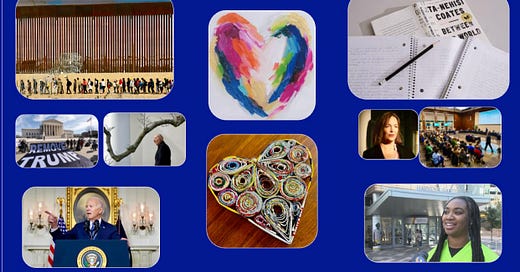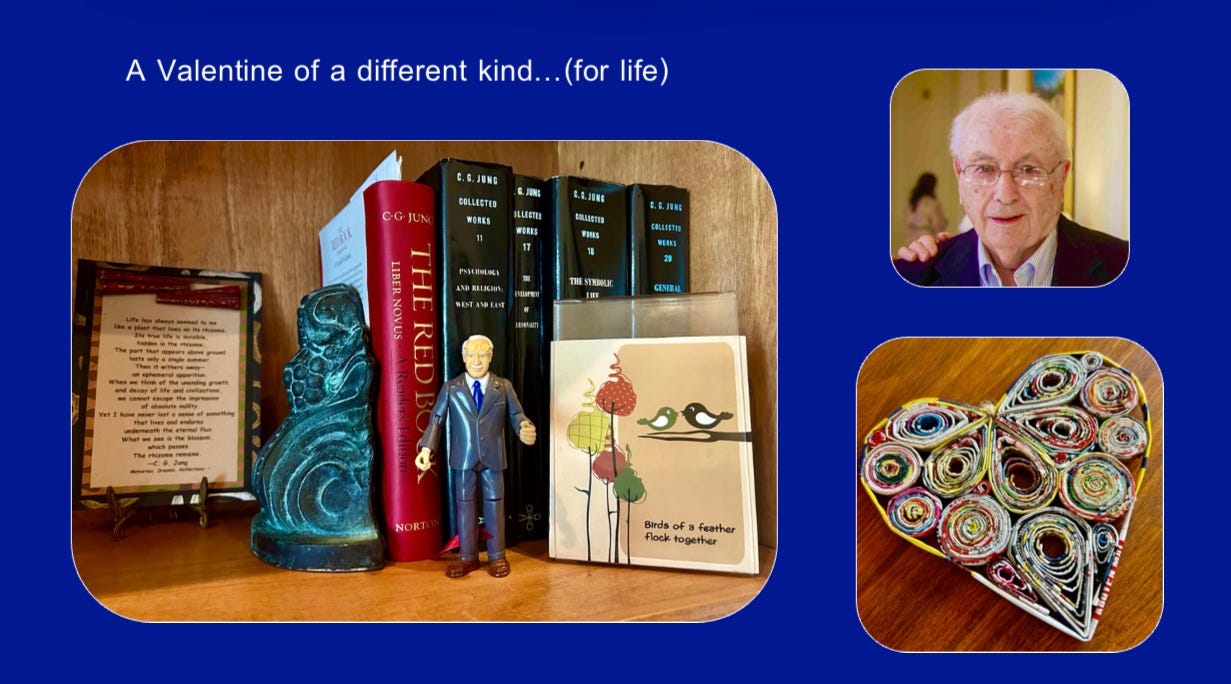Greetings, with news and history to spotlight — plus that quirky midweek pairing of “heart-and-soul-” type holidays.
All in all, rather a newShrink kind of week.
In focus on the news side are developments in three stories/issues of ongoing concern on national and international stages. A good week-overview is Friday night’s PBS News Hour (both video and full transcript here):
Headlines, quotes and links below recap the current state of things.
A caveat: This first section is longer with more of my thoughts. The week’s news (and shenanigans) from Congress have brought back to mind facets of this issue that’s a soap-box topic for me.
Immigration
Long before this week, this is a matter of massive, decades-long failure of morality and governance. One could make a sound argument that immigration is alongside the Vietnam War among worst American debacles with deep and far-reaching consequences, many of them tragic.
I am neither politician, pundit (nor card-carrying Republican!). Yet many can attest that I’ve pondered, pounded fists and on occasion written about this since at least 2007. That was the last time Congress failed to pass a promising comprehensive bipartisan bill with such significant measures — many supposedly sought by conservatives and moderates of both parties. That failed Comprehensive Immigration Reform bill is easy to remember. It’s the last, and only the second-ever, time that I robustly supported Republican former President George W. Bush’s advocacy and leadership on most anything. (The other was his 2003 President’s Emergency Plan for HIV/AIDS prevention, treatment and research, whose funding and benefits have been cumulative.)
In the breakdown of this week’s border-protection and Ukraine/Israel funding deal, it’s easy to note — and too easy to over-attribute — candidate Donald Trump’s widely reported political pressure on Congressional Republicans as primary factor. Candidate Trump did loudly demand they oppose even long-desired measures that would give his incumbent rival President Biden a prime political win before the November election.
That illustrates exactly how Trump Republicans care about needed solutions or effective governing on immigration, or apparently much of anything beyond preserving power and gaining more of it. The tone of disgust here reflects my increased cynicism about meaningful change, without some major shift in our collective consciousness and discourse on this issue (as with so many others.)
In at least two key areas our publicly popular, widely expressed policy-advocacy stances on immigration range from breathtakingly disingenuous to blatantly dishonest. One is basic economics. Any border-protection and overall immigration policy proposal or discussion completely lacks credibility when it ignores and denies the elephant-in-the-room of developed/developing nations throughout human history, and old as America itself. That is, with growth and “progress” the inherent, concurrent basic need for a large low-paid, low-advancement, low-expectation (marginalized) workforce of heavy-laborers across the full spectrum of human life.
The rationale for so many popular “positions,” glibly stated in socially acceptable terms, ought to collapse at casual-conversation level. But they don’t. We’re all too civilized and polite to ask at a social or extended-family gathering, club, or church such mundane questions as: How have you been able to build such enormous McMansions? Who’s making all of those leaves magically disappear from our mock-pastoral landscapes, quickly replaced by neatly packed mulch and correct-seasonal plants and holiday ornaments? Who hires and pays them? Who picks that specialty kale, off season fruit, red tip lettuce and romaine heart salad so essential to your family’s daily diet? More personally, who’s tending your injury-or illness-recuperating loved one, or the most intimate functions of your aged parents in long-term care? (Do you know? Or care?) And for all of us pragmatic, bottom-line focused business people, who cleans and services your factory floor, machines and offices at the bank or store or professional practice in off-hours, enabling your job-creator production to continue? How and where do they live in order to do this for us all? Who’s recruiting and providing all of this while you wave flags and yell about closing borders to them? Finally, who and what benefits from keeping these people invisible and powerless?
The above scenario — I promise! — is hyperbole to illustrate a point, not social-gathering conversation or routine public discourse I advocate, or do myself (except in occasional fantasy). And yet, these are some of the very kinds of questions with which we elect and supposedly expect people to wrestle to the mat. That is what governing is and looks like.
On immigration, even more compelling to me is at the level of morality for people of all religious faiths, and of none. It is specifically an article of faith for self-described evangelical Christians, so many of whom are immigration-hawks, who claim to want a Christian-theocracy version of America. Yet, as the mandate for Christians has been recalled eloquently in this week’s discourse, Judeo-Christian Scripture is clear about the welcome, care and protection of the stranger-foreigner in our midst and those seeking to be.
Again, it is simply disingenuous or blatantly dishonest when self-described Christians ignore and whitewash this in their politics. And in their more than comfortable lives.
(This concludes for now the newShrink soapbox on this issue.)
Here are headlines and stories.
Republicans Savage Border and Ukraine Deal, Threatening Its Survival (New York Times)
The day after a small group of Republicans and Democrats cemented a plan to clamp down on migration, G.O.P. leaders in both chambers denounced it as too weak, imperiling its path to enactment.
Top House and Senate Republicans on Monday savaged a $118.3 billion bipartisan compromise bill to crack down on unlawful migration across the U.S. border with Mexico and speed critical security aid to Ukraine, threatening to kill the deal’s chances of clearing a deeply divided Congress.
Senate votes to advance Ukraine-Israel package after border deal fails (WAPO)
More than a dozen Republicans joined with Democrats in 67 to 32 vote
Ukraine and Israel Aid Bill Inches Ahead as Divided G.O.P. Demands Changes (NYT)
Senate Republicans allowed the measure to move forward but were still slowing its progress as they held out for guarantees that they would be able to propose revisions.
And let’s not overlook Tucker Carlson’s weighing-in… with his good pal compadre Vladimir Putin.
Why the Kremlin Opened Its Doors to Tucker Carlson (Vanity Fair)
The former Fox News host has spent nearly the past two years defending Vladimir Putin and souring Republican support for Ukraine.
NC Senator Thom Tillis reverts to his old self in rejecting border deal (TheCharlotte Observer)
(By the weekend Tillis was again making noises in the opposite direction, of the all-sound-and-fury-and-signifying-nothing. variety.
🔵
Supreme Court hearing on Trump ballot eligibility
The likely outcome of this from the Court has seemed bipartisan if not unanimous, and driven largely by resistance to a federal presidential ballot or election being decided by a single state. (Which does beg the question of the 2000 Court allowing Florida to do just that, putting Bush and not Al Gore in the White House.)
As with so much since the 2020 election, particularly the unprecedented Trump-inspired January 6th violent interference with peaceful transfer of power, this is such an unprecedented time and case that I find just the mechanics of democratic institutional process itself reassuring. It seems the gavel-to-gavel respectful rhythm of arguments and justices’ questions must soothe the avid Supreme Court-nerd in me!
Here, that greater reassurance — perhaps democracy’s still alive and kicking? — emerges in the repeated loops back to historic case law for threads to inform present proceedings and serve ultimate future outcomes, good or bad. This to me is the essence of Constitution and law as living entities.
In my view a weaving it forward can also make engaging with Biblical, other sacred, literary and scholarly texts a similar alive process. And such weaving it forward between past and future can also serve our personal individuation. In a way it’s like being journalists in our own lives, researching to find, connect and report deepest threads of our own story.
Supreme Court justices appear skeptical of effort to remove Trump from a state ballot (NPR)
🔵
By Friday the David Brooks-Jonathan Capehart PBS program linked above and various news coverage had captured most of my thoughts about the Biden special counsel report. The report had many extraneous comments that were jarring in tone and to me inappropriately unprofessional. To my clinical ear both the report and pretty much all of the public pontificating about memory loss and age is simplistic, reflects lack of understanding of how normal memory works.
Just as a point of logic I will note that it’s not possible for any of us to both do things “willfully” (with conscious intent) and also be too doddering and unconscious to know and be held accountable for what we’ve done. Basically this special counsel has in effect declared President Biden not guilty (but only) by reason of insanity — without ever charging or putting him on trial. Prosecutors just don’t get to do that.
Special counsel: No charges for Biden in classified documents probe (WAPO)
Report cites weak evidence of intent by Biden, ‘an elderly man with a poor memory’
Special counsel alleged Biden couldn't recall personal milestones. His response: 'My memory is fine' (WAPO)
Biden angrily pushes back at special counsel's report that questioned his memory, handling of docs (WAPO)
🔵
This month the above themes and echoes of history also have a more specific focus.
Black history month
This well-reported and told story brings to vivid, personal life one AP English teacher’s efforts to live, work and make sense of the current culture wars and new dictates on how and whether to teach about race. I highly recommend and don’t think I can add anything to the full read. The later sections about her son, and other students at the school board meeting, are particularly powerful.
Students reported her for a lesson on race. Then she taught it again. (WAPO)
CHAPIN, S.C. — Mary Wood walked between the desks in her AP English Language and Composition classroom, handing out copies of the book she was already punished once for teaching.
Twenty-six students, all but two of them White, looked down at Ta-Nehisi Coates’s “Between the World and Me,” a memoir that dissects what it means to be Black in America — and which drew calls for Wood’s firing when she tried to teach it last year in her mostly White, conservative town. Wood crossed to a lectern and placed her hands on either side of a turquoise notebook, open to two pages of bullet points explaining why she wanted to teach Coates’s work.
Her students reported her for a lesson on race. Can she trust them again?…
🔵
Here’s a timely story figuratively closer to home.
NC State student creates site map of Charlotte’s lost slavery history (WSOC-TV, Charlotte ABC News affiliate)
(Here’s the original story back in 2022 when Alexander first created the map as a Girl Scout project and won an award for it.)
The Myers Park High School senior created a walking tour after learning some of the stories of slaves living and working in Uptown.
The historic slavery-map is also literally close to home for me. That Charlotte center-city quadrant holds meaningful sites — an astonishing number with markers for their past significance — in my late mother’s life and family plot in center-city historic, once racially divided, cemetery. These could be an interesting combined walking-tour.
🔵
Weaving it forward
As noted in previous editions, the recent sheer volume, review and excavation of documents, memorabilia and photos in settling my mom’s affairs evoked visions of fantasy-February bulldozers to clear remaining abundance of stuff. I’m finding instead it’s a time not for bulldozers, but rather now to cull and curate, bring forward just what’s alive and meaningful. Borrowing from Nabokov, it’s to speak memory via story, image, experience — not over-attachment to silent, too-plentiful things, even beautiful ones. (And meaningful heirloom shrubs need not be literally transplanted in perpetuity to remain forever fiercely alive.)
Which brings me to this week’s strange overlapping holidays. Their jarring different tones, imagery and rituals are the stuff of Jungian nightmares!
First with Fat Tuesday, some longtime readers may recall how I’m not a fan of those colorful Fat Tuesday King Cakes in Mardi Gras colors. The prospect of being the one to bite into the cake’s hidden plastic Baby Jesus just doesn’t scream “good luck” to me!
Then Ash Wednesday, beginning the pensive season of Christian Lent, is on Valentine’s Day. How does one decide what to do first?!
Joking aside, it’s a perfect year for the way I choose to observe Lent. (This is described in previous years’ editions, browsable on the website at newshrink.substack.com.) It’s basically: For sound psychological/neurological reasons and some spiritual ones, each of the season’s 40 days begins and repeats a desired new positive habit or practice. This year here that’s to be some of the above cull-and-curate process — daily.
🔵
Lent hasn’t begun yet. Meanwhile a recent priceless story is becoming my favorite Valentine, maybe ever. Here it’s told in three parts, with pictures.
The story’s main character is my near-96-year-old beloved, lifelong honorary “Uncle M.” By education he’s Clemson-and-military-trained engineer/businessman. By nature he’s introverted thinker and voracious-eclectic reader. So both ways he’s profoundly, even gruffly private, dislikes (even this much) public display.
That’s all in stark dramatic contrast to the voluntary lead speaking-role he spontaneously plays in this story. Others key figures are his wife my “Aunt J,” and my mother. (Another lifelong honorary “Aunt L” is pictured and mentioned.)
The setting is the January celebration of my late mom. This first photo depicts part of a continuing-loop slideshow on large screen backdrop throughout the gathering. Uncle M’s part is in response to this one.
Most elements of this picture, I have known all my life: That my mother, Uncle M and Aunt L were born the same 1928 May, in the same Charlotte hospital. Then at junior high my mother met my Aunt J, the girl pictured with her, and they were close friends ever since. Long-familiar stuff; our families have celebrated all of these people’s birthdays and much else together over decades.
This is the part where, in a roomful of people big enough for mics and name tags, my Uncle M raises his hand. In characteristic matter-of-factness he delivers surprises decidedly not in-character. For me there were lovely new factual pieces.
But the stunning, etched-forever memory image is this precious man, in steady gaze with me across a roomful of people, as he calmly picks up a mic. With firmly relaxed voice, he effectively serves-up his heart and soul to us all.
Here is my recall:
“Jane and I were born the same week in May. It was at Saint Peter’s Hospital in downtown Charlotte. I never saw or met her then.
Though I am sure I probably heard her.”
He describes his later first actual seeing/meeting my mother with a novelist’s descriptive detail. Speaking memory… he does!
“I didn’t see and meet Jane in person until the beginning of the 7th grade. That was at Alexander Graham Junior High School, on Morehead Street in Charlotte." [For Charlotteans: AG in those years was on the site of what has long been the Dowd YMCA.]
“I saw this girl, Jane. She was standing at a railing. It was up on this balcony…
…. And on that balcony, standing beside her, was this other girl….
That girl was J….
J is the woman I am married to, have been for nearly 73 years.”
So many powerful things converged in that eye-to-eye time with him. I’d never known he’d first met Mother and my beloved Aunt J together.
But the lasting memory is this nearly 96-year-old man’s exquisitely specific, public recollection of how, when and where he first laid eyes on that 11-year old girl in the picture, who’d be his wife.
Reflecting together on this later, he told me with astonishment in his voice:
"Why, I just remember every detail of that!”
The story and the telling have a bittersweet note. For while Aunt J is engaged and life-loving as ever, she wasn’t able to attend the event. Her mobility issues have required her recent move to their community’s health care area, with Uncle M visiting her daily from their apartment. It’s an understandably big adjustment for them both.
That’s made his loving public tribute especially dear.
So with these next two photos here is my current, maybe forever, favorite Valentine!
(Then, happily able to celebrate them both last Saturday…)
(And finally, there’s a newShrink-themed footnote to this story…)
Over all of my life, Uncle M and I’ve shared a special bond, have just gotten each other — a lot but not all around ideas and books. Specifically, over many decades we have shared a passion, exhaustive depth and breadth of reading and study of Jung and his analytical psychology. Way back, each of us had been drawn separately by our individual variety of lures. I realize now that was at about the same time, when I was very young and he was barely middle-aged.
Since their move to smaller quarters in a retirement community several years ago, Uncle M’s Collected Works of Jung and much of his library now stay with mine.
The apt “birds of a feather ” photo was his birthday card to me some years back.
And appropriately enough, the heart from 10,000 Villages is a piece re-created out of tightly folded printed newspaper… woven together to form a new shape.
🔵
And, that is all I have! Talk to you next week..
🦋💙 tish
… it is important that awake people be awake,
or a breaking line may discourage them back to sleep;
the signals we give — yes or no, or maybe —
should be clear: the darkness around us is deep.
— William Stafford, “A Ritual to Read to Each Other”
🔵







